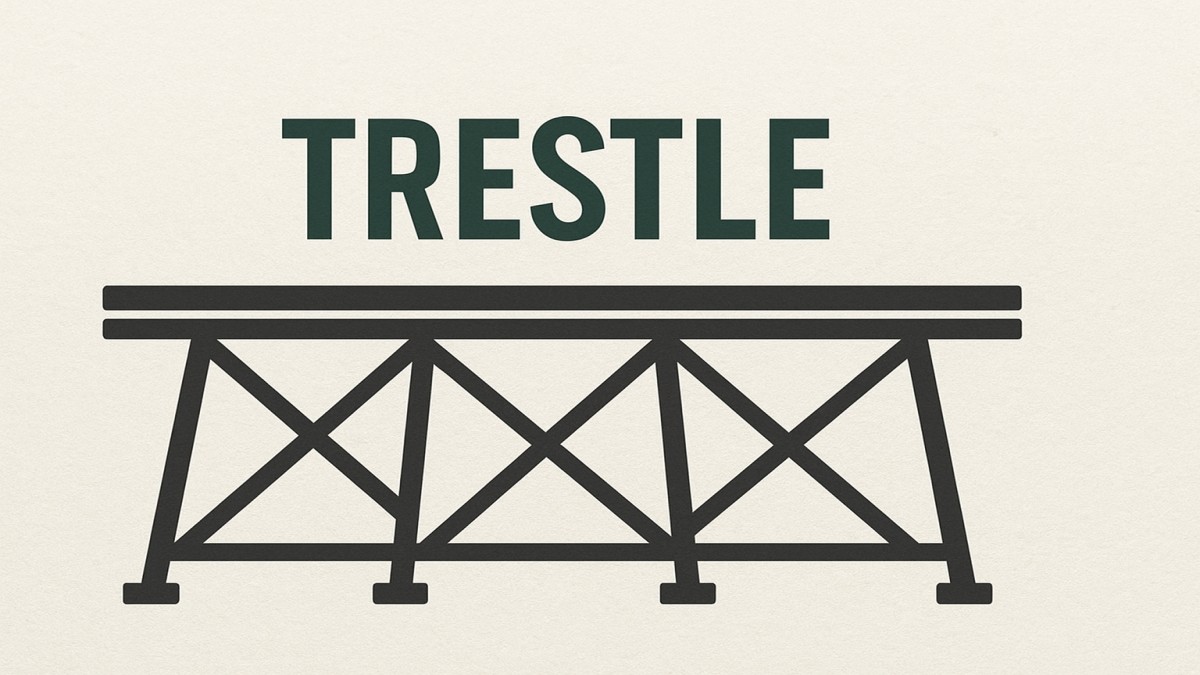Introduction to Trestle
A trestle is a simple yet powerful structure that has shaped architecture, railroads, and even our dining culture. Whether you’re crossing a wooden railway bridge in the countryside or sitting at a rustic trestle table in a farmhouse kitchen, this structure has left a deep imprint on human history.
Etymology and Origin
The word “trestle” comes from the Latin transtrum, meaning “crossbeam.” Over centuries, the term evolved to describe frames built from beams and braces. In medieval times, trestles were mostly associated with tables and benches used during feasts.
Types of Trestles
Trestles come in different forms depending on their purpose:
- Wooden trestles – popular in the 19th century for railway bridges.
- Steel trestles – durable and capable of handling heavy loads.
- Concrete trestles – used in modern bridges for stability.
- Temporary trestles – often built at construction sites.
Trestle Bridges
A trestle bridge is made of short spans supported by closely spaced frames. They are economical and quick to build, which is why they were widely used during the American railroad boom.
Famous example: The Goat Canyon Trestle in California, one of the largest curved wooden trestles in the world.
Railroad Trestles
In the 1800s, railroad expansion relied heavily on trestles to cross valleys and rivers. They were cheaper to build than stone or iron bridges and allowed trains to move across rugged terrain. Though many have been replaced, some wooden railroad trestles still stand as engineering marvels.
Trestle Tables
In medieval Europe, feasts were held on trestle tables — simple boards laid across trestle supports. These tables could be dismantled quickly, making them practical for castles and banquet halls. Today, trestle dining tables are popular for their rustic charm and space-saving design.
Military Use of Trestles
Trestles weren’t just for railroads and kitchens. In wars, armies used portable trestle bridges to move troops and supplies across rivers quickly. Their simple design made them a vital tool in military engineering.
Engineering and Design Aspects
A trestle’s strength lies in its triangular bracing system, which distributes weight efficiently. Engineers consider load capacity, span length, and material choice when designing trestles for long-term use.
Advantages of Trestles
- Low-cost compared to large bridges
- Flexible in design for different terrains
- Quick to construct with local materials
Disadvantages of Trestles
- Limited span length
- High maintenance for wooden trestles
- Vulnerability to fire and weather damage
Modern Applications of Trestles
- Construction sites: Temporary support structures.
- Furniture: Stylish trestle tables for homes and events.
- Bridges: Pedestrian and railway crossings in rural areas.
Environmental Impact
Wooden trestles use natural materials but require deforestation, while steel and concrete trestles demand high energy consumption. Modern engineers focus on sustainable materials to reduce the environmental footprint.
Famous Trestle Structures Worldwide
- Goat Canyon Trestle (California, USA) – Largest wooden curved trestle.
- Kinzua Bridge (Pennsylvania, USA) – Once the tallest railroad trestle in the world.
- Stoney Creek Trestle (British Columbia, Canada) – Still active for trains today.
Future of Trestle Design
As technology evolves, trestles are being redesigned with advanced composites and 3D modeling to improve strength and sustainability. Future trestle bridges may combine traditional aesthetics with cutting-edge engineering.
Conclusion
From medieval banquet halls to towering railroad bridges, the trestle has played a vital role in human progress. Its simplicity, versatility, and enduring design continue to inspire engineers, architects, and furniture makers alike.
FAQs
1. What is a trestle bridge?
A trestle bridge is a bridge supported by a series of short spans resting on closely spaced frames.
2. Why were trestles important in railroad history?
They allowed trains to cross valleys and rivers cheaply and efficiently during the 19th-century railroad expansion.
3. Are trestle tables still used today?
Yes, trestle tables are popular in homes, restaurants, and events for their rustic and practical design.
4. What materials are used to build trestles?
Traditionally wood, but modern trestles also use steel, reinforced concrete, and composite materials.
5. What is the most famous trestle in the world?
The Goat Canyon Trestle in California is one of the most iconic and largest curved wooden trestles.

 Blog2 months ago
Blog2 months ago
 education2 months ago
education2 months ago
 Blog2 weeks ago
Blog2 weeks ago
 News2 months ago
News2 months ago



















